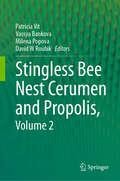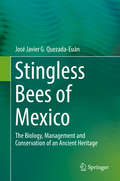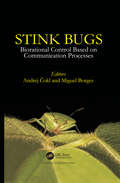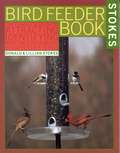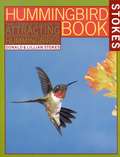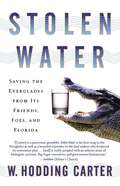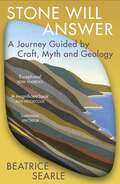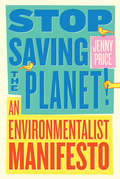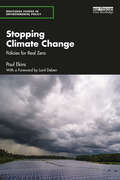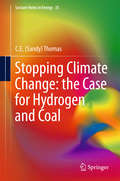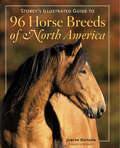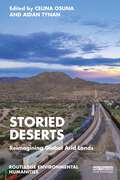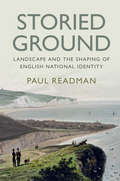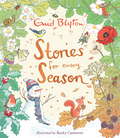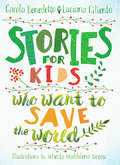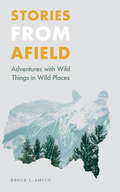- Table View
- List View
Stingless Bee Nest Cerumen and Propolis, Volume 2
by Patricia Vit Milena Popova Vassya Bankova David W RoubikMeliponini, the stingless bees of the tropics, process and store honey, pollen and plant resins to maintain their colonies. The chemical components of their nests are bioactive and believed to be therapeutic for a long list of maladies. However, only recently are tests and analyses being done with molecular and modern laboratory techniques, such as high throughput EDX, HPIC, HPLC, GC, NMR, PCR, and ultrastructural SEM; coupled with diverse detectors such as DAD, RI, MS, SCD.This two-volume book is about the cerumen –plant resins mixed with stingless bee wax– and propolis, which fortify the colony in ways that are beginning to be understood. It includes reviews and new research on diverse topics involving the chemistry and bioactivity of plant resins, cerumen, propolis, besides bee and microbe behavior and ecology. These analytic studies are presented along with stingless bee biodiversity, palynology, cultural knowledge, bee foraging behavior, resin flower evolution, ecology, and evolution of nest microbe mutualisms, social immunity, human health, the decisive role of microbiology investigation in moving forward, natural history of stingless bee colonies and nests, marketing, and bibliometrics for plant resin use by bees, propolis, and the Starmerella yeast.
Stingless Bees of Mexico
by José Javier Quezada-EuánThe stingless bees are the most diverse group of highly social bees and are key species in our planet’s tropical and subtropical regions, where they thrive. In Mexico, the management of stingless bees dates back centuries, and they were an essential part of the culture and cosmogony of native peoples like the Maya. In recent decades a vast amount of information has been gathered on stingless bees worldwide. This book summarizes various aspects of the biology and management of stingless bees, with special emphasis on the Mexican species and the traditions behind their cultivation. Much of the information presented here was produced by the author and the team of researchers at the Universidad Autónoma de Yucatán in the course of three decades of working with these insects. Given the breadth of its coverage, the book offers an equally valuable reference guide for academics, students and beekeepers alike.
Stinkbugs: Biorational Control Based on Communication Processes
by Andrej Cokl Miguel BorgesThis book presents an overview of the Pentatomidae species, covering their biology, phylogeny and reproductive behavior, main plants used in their diet and their nutritional exigencies, predatory stinkbugs, interactions between herbivores-plants and natural enemies, use of pheromone for monitoring phytophagous populations, and chemical and vibrational communication signals. It also presents possible technologies to be applied in field crops for pest management that could be developed as the basis of the interplay of stink bug communication signals.
Stokes Bird Feeder Book: The Complete Guide to Attracting Identifying and Understanding Your Feeder Birds
by Donald Stokes Lillian StokesEssential information that backyard nature enthusiasts want and need -- to attract, identify, and understand birds and butterflies, and to grow and identify beautiful wildflowers at home. Donald and Lillian Stokes are widely recognized as America's foremost authorities on birds and nature. They are the hosts of the PBS television series BirdWatch with Don and Lillian Stokes
Stokes Birdhouse Book: The Easy Guide to Attracting Nesting Birds
by Lillian Stokes DonaldCopiously illustrated with line drawings and full-color photographs, this large format paperback book contains the essential information that backyard nature enthusiasts want and need -- to build and seek out birdhouses, including the right birdhouse for many popular species .
Stokes Hummingbird Book: The Complete Guide to Attracting, Identifying,and Enjoying Hummingbirds
by Donald Stokes Lillian StokesA pocket-size, brilliantly colorful, simple-to-use guide to hummingbirds, containing dozens of full-color photographs that enable readers of all ages to identify the most common species; range maps; tips on attracting hummingbirds, information on habitat needs, life cycle, food preferences; and much more.
Stolen Pony
by Glen Rounds(from the book jacket): Stolen! Locked in a swaying truck, the little blind pony snorts with terror. Horse thieves captured him in the dead of night. And now he is being carried farther and farther from home. What will happen when the thieves find out he is blind? Will they turn him loose? But how can a blind pony find his way home?
Stolen Water
by W. Hodding CarterWhen the Comprehensive Everglades Restoration Plan went into effect during the Clinton administration, Florida's great grassy wilderness garnered a host of national attention -- and has since become a breeding ground for environmental dispute. What does it take to "save" a forest? How can it be preserved? Enter W. Hodding Carter. For an Outside magazine feature he's agreed to paddle the ninety-nine-mile waterway in Everglades National Park to examine the landscape from all angles -- physical, political, cultural, and very personal -- and get to the rock-bottom heart of the story. Stolen Water is the outgrowth of Carter's journey. Through investigative research, eyewitness accounts, and interviews with key players in the conservation controversy, Carter offers a rare portrait of a national treasure. Utterly important, and at times downright hilarious, Stolen Water is a classic American adventure tale, and an environmental parable for our time.
Stone Building: How To Make New England Style Walls And Other Structures The Old Way (Countryman Know How #0)
by Kevin GardnerA practical guide to simple stone building projects for your yard Nothing matches the look and feel of stone structures in and around your home. Yet most people are intimidated by the very thought of masonry, despite the obvious rewards. In Stone Building, Kevin Gardner distills his decades of experience building and maintaining iconic New England–style stone walls into this concise, informative guide. Gardner offers step-by-step instructions for building everything from flagstone walkways to classic patios and ornate fire pits. He also offers time-tested tips to help care for your stone, as well as repair and restoration advice for existing structures.
Stone Will Answer: A Journey Guided by Craft, Myth and Geology
by Beatrice SearleA beautiful memoir, travelogue and meditation on stone by artist and stone mason Beatrice Searle.'Extraordinary' Guardian‘A magnificent book’ Alex Woodcock‘Exceptional’ Kerri Andrews‘Luminous’ SpectatorAt the age of twenty-six, artist and Cathedral stonemason Beatrice Searle crossed the North Sea and walked 500 miles along a medieval pilgrim path through Southern Norway, taking with her a 40-kilogram Orcadian stone.Fascinated with the mysterious footprint stones of Northern Europe and the ancient Greco-Roman world, stones closely associated with travellers, saints and the inauguration of Kings, she follows in their footsteps as her stone becomes a talisman, a bedrock and an offering to those she meets along the way.Stone Will Answer is an unusual adventure story of journeys practical, spiritual and geological, of weight and motion, and an insight into a beguiling craft.
Stop Saving the Planet!: An Environmentalist Manifesto
by Jenny Price"Pithy, funny, exasperated, and informed…You cannot read a more important hundred pages than Stop Saving the Planet!" —Richard White, author of The Republic for Which It Stands We’ve been "saving the planet" for decades!…And environmental crises just get worse. All this hybrid driving and LEED building and carbon trading seems to accomplish little to nothing—and low-income communities continue to suffer the worst consequences. Why aren’t we cleaning up the toxic messes and rolling back climate change? And why do so many Americans hate environmentalists? Jenny Price says Enough already! with this short, fun, fierce manifesto for an environmentalism that is hugely more effective, a whole lot fairer, and infinitely less righteous. She challenges you, corporate sustainability officers, and the EPA to think and act completely anew—and to start right now—to ensure a truly habitable future.
Stopping Climate Change: Policies for Real Zero (Routledge Studies in Environmental Policy)
by Paul EkinsWritten by one of the leading experts in the field, Paul Ekins, Stopping Climate Change provides a comprehensive overview of what is required to achieve ‘real zero’ carbon dioxide emissions by 2050, and negative emissions thereafter, which is the only way to stop human- induced climate change. This will require innovation in socio-technical systems, and in human behaviour, on an unprecedented scale. Stopping Climate Change describes the changes required to meet this goal: in technologies, social institutions and individual activities. Paul Ekins examines in detail issues around the supply and demand of energy and materials, and the efficiency of their use. It also analyses greenhouse gas removal technologies, offsetting and geoengineering, and plots the reduction of the non- CO2 greenhouse gas-emitting activities. Having set out the changes required, Ekins considers the economic implications, in terms of both the innovation and investments that are necessary to bring them about, and the effects that these are likely to have on national economies. The evidence presented points clearly to the economic impacts of decarbonisation being positive for the majority of countries, and for the world as a whole, even before considering the benefits of avoided climate change. When the health benefits of stopping the burning of fossil fuels are factored in, the global net benefits of decarbonisation are unequivocal. Drawing on examples from the UK and Europe, but with wider relevance at a global scale, Stopping Climate Change clearly shows how determined policy action at different levels could stop climate change. It will be of great interest to students, scholars and policymakers researching and working in the field of climate change and energy policy.
Stopping Climate Change: Policies for Real Zero (Routledge Studies in Environmental Policy)
by Paul EkinsWritten by one of the leading experts in the field, Paul Ekins, Stopping Climate Change provides a comprehensive overview of what is required to achieve ‘real zero’ carbon dioxide emissions by 2050, and negative emissions thereafter, which is the only way to stop human- induced climate change.This will require innovation in socio-technical systems, and in human behaviour, on an unprecedented scale. Stopping Climate Change describes the changes required to meet this goal: in technologies, social institutions and individual activities. Paul Ekins examines in detail issues around the supply and demand of energy and materials, and the efficiency of their use. It also analyses greenhouse gas removal technologies, offsetting and geoengineering, and plots the reduction of the non- CO2 greenhouse gas-emitting activities. Having set out the changes required, Ekins considers the economic implications, in terms of both the innovation and investments that are necessary to bring them about, and the effects that these are likely to have on national economies. The evidence presented points clearly to the economic impacts of decarbonisation being positive for the majority of countries, and for the world as a whole, even before considering the benefits of avoided climate change. When the health benefits of stopping the burning of fossil fuels are factored in, the global net benefits of decarbonisation are unequivocal.Drawing on examples from the UK and Europe, but with wider relevance at a global scale, Stopping Climate Change clearly shows how determined policy action at different levels could stop climate change. It will be of great interest to students, scholars and policymakers researching and working in the field of climate change and energy policy.
Stopping Climate Change: the Case for Hydrogen and Coal
by C. E. Sandy ThomasThis book documents the advantages and limitations ofvarious electricity generation methods. It illustrates how both electricity andmotor fuel can be cost-effectively derived from coal, natural gas or other indigenousfuels, thereby eliminating our dependence on imported oil and the power of OPEC. It favours electricity generation systems powered exclusively by natural gas,coal, nuclear and renewables and motor vehicles powered by hydrogen(electricity from coal gasification with carbon capture and sequestration (CCS)and hydrogen as the fuel powering fuel-cell electric vehicles produced from naturalgas or by gasifying coal With CCS. ) Thebook also demonstrates that the US can meet the Climate Change goal of reducingall greenhouse gases by 80% below 1990 levels in both the transportation andelectric utility sectors using hydrogen and coal.
Store of Infinity: Stories
by Robert SheckleyIn &“The Prize of Peril,&” everyone lives on . . . because when someone is about to die, the emergency squad is always there to bring that person back—whether he or she wants it or not. The seven other stories in this collection are &“The Humours,&” &“Triplication,&” &“The Minimum Man,&” &“If the Red Slayer,&” &“The Store of the Worlds,&” &“The Gun Without a Bang,&” and &“The Deaths of Ben Baxter.&” From the very beginning of his career, Robert Sheckley was recognized by fans, reviewers, and fellow authors as a master storyteller and the wittiest satirist working in the science fiction field. Open Road is proud to republish his acclaimed body of work, with nearly thirty volumes of full-length fiction and short story collections. Rediscover, or discover for the first time, a master of science fiction who, according to the New York Times, was &“a precursor to Douglas Adams.&”
Storey's Illustrated Guide to 96 Horse Breeds of North America
by Judith DutsonFrom the Pryor Mountain Mustang to the Tennessee Walking Horse, North America is home to an amazing variety of horses. In this lavish, photograph-filled guide, Judith Dutson provides 96 in-depth profiles that include each breed&’s history, special uses, conformation standards, and more. You&’ll learn about homegrown favorites like the Morgan, Appaloosa, and Quarter Horse, as well as exotic imports like the Mangalarga Marchador and the Selle Français. Take a continental horse tour without ever leaving your home.
Storey's Illustrated Guide to Poultry Breeds: Chickens, Ducks, Geese, Turkeys, Emus, Guinea Fowl, Ostriches, Partridges, Peafowl, Pheasants, Quails, Swans
by Carol EkariusMore than 128 birds strut their stuff across the pages of this definitive primer for intrepid poultry farmers and feather fanciers alike. From the Manx Rumpy to the Redcap and the Ancona duck to his Aylesbury cousin, each breed is profiled with a brief history, detailed descriptions of identifying characteristics, and colorful photography. Comprehensive and fun, Storey’s Illustrated Guide to Poultry Breeds celebrates the personalities and charming good looks of North America’s quirkiest barnyard birds and waterfowl.
Storie di mare
by Carmelo Massimo Tidona Steve VernonAffrontiamo la verità. Circa il settantacinque per cento del mondo è coperto di acqua – e di quell’acqua, circa il novantasette per cento si trova in mare. I naviganti vi diranno che c’è una storia per ogni onda che si è mai abbattuta sulla riva. Qui ci sono sette di quelle storie. "Nelle oscure profondità" offre un’inquietante assaggio del servizio di scorta durante la Seconda Guerra Mondiale, e di un marinaio che ha fatto e mantenuto un terribile patto. "La sirena di Harry” vi presenta un gruppo di uomini senza dimora che pescano qualcosa che POTREBBE essere una sirena. Se questo non vi dice abbastanza sul racconto, provate a immaginare come sarebbe Vicolo Cannery di Steinbeck se fosse stato scritto da HP Lovecraft. "So perché l’acqua del mare sa di sale" è la storia di un pilota kamikaze dell’aviazione giapponese di stanza a Okinawa e del suo incontro con un mostro marino, più o meno. "La storia di Finbar" è una storia dark fantasy delle correnti più profonde che si agitano tra le profonde correnti silenziose del freddo cuore di un uomo. "La donna che perse un dente per aver riso troppo forte del mare" è una piccola tranquilla fiaba che parla d’acqua salata, lacrime e rimorsi. "Tra chi-sai-tu e il profondo blu" è la storia dell’ultimo patto sulla terra. Questa raccolta inizia con un patto e finisce con un patto... cosa che a me sembra un ottimo patto. "Se Harlan Ellison, Richard Matheson e Robert Bloch avessero una serata di sesso a tre in una vasca d’acqua calda, e poi un gruppo di scienziati entrasse e filtrasse l’acqua e mescolasse il DNA rimasto in una provetta, l’esperimento genetico risultante molto probabilmente crescerebbe per diventare Steve Vernon." - Bookgasm
Storied Deserts: Reimagining Global Arid Lands (ISSN)
by Aidan Tynan Celina OsunaStoried Deserts makes a crucial and critical intervention in the field of environmental humanities by showcasing an emerging body of research on desert places from around the world.Deserts, despite dominant stereotypes of wasteland and barrenness, are culturally and ecologically abundant places. This edited volume sets out to reimagine the world’s desert places and the very concept of "the desert" itself, taking a boldly interdisciplinary and multicultural approach. Authors engage in literary ecocriticism and ecopoetics, film and visual studies, critical theory, personal and transdisciplinary reflection, creative practices, and historical scholarship. Through their diverse range of perspectives, contributors show how arid lands have been and can be understood as sites of narrative production, places where signs and imaginaries are born from the materialities of space and entanglement. In this way, this volume highlights how the storied matter of the Earth’s deserts informs lived realities, environmental histories, cinematic and literary imaginaries, political conflicts, and even intellectual categories such as "the human" and "the elemental".Ultimately, this book shows that reimagining desert places can help us to grapple with the epochal challenges of the Anthropocene. It is an important and engaging collection for scholars and students across disciplines that helps establish the value of desert humanities.
Storied Ground: Landscape and the Shaping of English National Identity
by Paul ReadmanPeople have always attached meaning to the landscape that surrounds them. In Storied Ground Paul Readman uncovers why landscape matters so much to the English people, exploring its particular importance in shaping English national identity amid the transformations of modernity. The book takes us from the fells of the Lake District to the uplands of Northumberland; from the streetscapes of industrial Manchester to the heart of London. This panoramic journey reveals the significance, not only of the physical characteristics of landscapes, but also of the sense of the past, collective memories and cultural traditions that give these places their meaning. Between the late eighteenth and early twentieth centuries, Englishness extended far beyond the pastoral idyll of chocolate-box thatched cottages, waving fields of corn and quaint country churches. It was found in diverse locations - urban as well as rural, north as well as south - and it took strikingly diverse forms. Seeks to explain the roots of modern English national identity through novel case study approach, using familiar and iconic landscapes such as the White Cliffs of Dover and the River Thames; The writing style is lively and accessible, so will appeal to a wide range of readers; The book has a broad chronological coverage and uses extensive illustrations to help readers visualise the places and cultural artefacts discussed in the text.
Stories for All Seasons (The Enchanted Library #5)
by Enid BlytonA gorgeous picture book to delight all little readers, with stories for every season. Collect the whole series for a year-round library of beautiful books. Discover busy birds, seaside adventures, twelve fairy coats and frost patterns in this beautiful collection of stories by the world's best-loved storyteller, Enid Blyton. With charming colour illustrations by Becky Cameron, acclaimed illustrator of Treasury of Bedtime Stories by Enid Blyton and of Paddington and the Christmas Wish, this is the perfect gift.Step into a world of magic and nature with The Enchanted Library series. Look out for:Stories of Nature's TreasuresStories of Favourite FriendsStories of Animal SecretsStories of Dreamy AdventuresStories of Starry NightsStories of Fairy FunStories of Woodland AdventuresStories for Cosy DaysStories of Tasty Treats * Enid Blyton ® and Enid Blyton's signature are Registered Trademarks of Hodder and Stoughton Limited. No trademark or copyrighted material may be reproduced without the express written permission of the trademark and copyright owner.
Stories for Every Season
by Enid BlytonA beautiful treasury of stories for every season from one of the world's best-loved storytellers. With gorgeous full-colour illustrations throughout, this collection will delight at any time of the year and makes the perfect gift.Step into a world of magic and nature, where elfin tailors make clothes from autumn leaves and a spring lamb remembers a kind little girl. Join a fawn as it shelters from a summer storm, learn how to help birds keep warm in cold weather and share the wonder of the seaside, where you might just meet a fairy in a seashell . . . Divided into four sections to reflect the seasons, this treasury contains 28 timeless stories from Enid Blyton's archives - plus a bonus extra story for Christmas. Some of these wonderful tales are collected in book form for the very first time. It is gorgeously illustrated by Becky Cameron, acclaimed illustrator of Treasury of Bedtime Stories by Enid Blyton and of Paddington and the Christmas Wish. Look out for these other gorgeous Enid Blyton gift books: Treasury of Bedtime StoriesThe Famous Five TreasuryJolly Good Food (a children's cook book)Favourite Enid Blyton Stories*Enid Blyton ® and Enid Blyton's signature are Registered Trademarks of Hodder and Stoughton Limited. No trademark or copyrighted material may be reproduced without the express written permission of the trademark and copyright owner.
Stories for Every Season
by Enid BlytonA beautiful treasury of stories for every season from one of the world's best-loved storytellers. This audiobook collection will delight at any time of the year and makes the perfect gift. <p><p> Step into a world of magic and nature, where elfin tailors make clothes from autumn leaves and a spring lamb remembers a kind little girl. <p><p>Join a fawn as it shelters from a summer storm, learn how to help birds keep warm in cold weather and share the wonder of the seaside, where you might just meet a fairy in a seashell . . . <p><p>Divided into four sections to reflect the seasons, this treasury contains 28 timeless stories from Enid Blyton's archives—plus a bonus extra story for Christmas. Some of these wonderful tales are collected in book form for the very first time. <p><p>Look out for these other gorgeous Enid Blyton gift books: Treasury of Bedtime Stories, The Famous Five Treasury <p>*Enid Blyton ® and Enid Blyton's signature are Registered Trademarks of Hodder & Stoughton Limited. No trademark or copyrighted material may be reproduced without the express written permission of the trademark and copyright owner.
Stories for Kids Who Want to Save the World
by Carola Benedetto Luciana CilientoSixteen biographies of extraordinary people--ranging from Sebastião Salgado to Björk and Greta Thunberg--who came of age fighting climate changeEvery person has a path in life, one that is intertwined with the fate of the earth. The life stories in this collection begin and end with that realization. First, as children, in different countries and eras, they witness how humans provoke environmental degradation. Each leads a life that not only minimizes their individual contribution to climate change at a local scale, but also that of their generation on a global scale. Then, as adults, they recognize the maturity and agency acquired at that moment which defined their lives. The biographies depict concrete initiatives that contribute to climate preservation, from a physicist who promotes organic farming techniques in India to a designer that only uses ecological fabrics and dyes in Italy. Rock climber Yvon Chouinard, biologist Rachel Carson, and designer Adriana Santanocito are included in this diverse cast of environmental activists. Together they show us that regardless of culture, class, or profession it is never too early or late to find your way to improve the world our children will inhabit. The stakes couldn't be higher: "Our house is on fire," as Greta Thunberg rightly said.
Stories from Afield: Adventures with Wild Things in Wild Places (Outdoor Lives)
by Bruce L. SmithOver the past four decades, Bruce L. Smith has worked with most big-game species in some of the American West’s most breathtaking and challenging landscapes. In Stories from Afield, readers join Smith on his adventures as a naturalist, sportsman, and wildlife biologist, as he pulls us into the field of learning and discovery across wilderness areas of western Montana, the National Elk Refuge in Jackson Hole, Wyoming, and a South African temperate forest. Ranging from humorous to harrowing, Smith’s essays recount capturing newborn elk calves, stalking mountain goats on icy cliffs, being stranded on a mountain after riding out a helicopter crash, confrontations with bears during his research, plus quirky and edifying hunting tales. Throughout his adventures, the magnetism and danger of wild nature are ever present, reminding us that our fascination with wildness often stems from its unpredictability.
